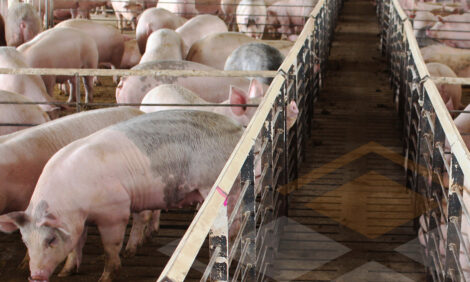



Effects of increasing dietary Lysine in Transition diets on nursery pig growth performance
By J.M. DeRouchey, M.D. Tokach, R.D. Goodband, J.L. Nelssen, S.S. Dritz, Food Animal Health and Management Center and J.L. Usry, Ajinomoto Heartland Lysine, Illinois. Published in Kansas State University's Swine Day 2003. In this article, a total of 1,400 weanling pigs (initially 13.6 lb) was used in a 9 d growth assay (d 4 to 13 postweaning) to determine the effects of increasing lysine in the transition diet on nursery pig growth performance.Summary
All pigs were fed a common SEW diet until d 4 after weaning. Pigs were then switched to experimental diets with total dietary lysine levels of 1.40, 1.50, 1.60, 1.70 or 1.80%. All diets were formulated to contain 20% soybean meal, with increasing amounts of synthetic amino acids to achieve desired amino acid concentrations in the diets. From d 4 to 9 postweaning, increasing lysine increased ADG (linear, P<0.03) and improved feed efficiency (linear, P<0.001), but ADFI was not affected. Overall (d 4 to 13 postweaning), pigs fed diets containing increasing dietary lysine had improved ADG (linear, P<0.03) and feed efficiency (linear, P<0.001), with no differences in ADFI. Although responses to increasing dietary lysine were linear, there was little improvement either ADG or F/G above 1.7% lysine. There was no difference in average pig weight at the end of the trial, probably because of the short duration of the study. In conclusion, increasing dietary lysine up to 1.7% in transition diets (13 to 19 lb) for nursery pigs maximized growth performance.
Introduction
Nursery diets are routinely formulated to
contain a small amount of soybean meal, yet
not as much as to cause digestive complications.
When maximum soybean meal levels
are reached, other specialty protein products,
such as spray-dried animal plasma, blood
meal, fishmeal, and spray-dried whey are used
to meet the amino acid requirements.
However,
as levels of these products increase in the
diet, diet cost also increases. Another possible
means of increasing dietary lysine without using
excessive amounts of soybean meal or
specialty protein source levels is through the
use of crystalline amino acids.
Historically,
synthetic amino acid use was limited to lysine
and methionine because of the high cost of
other amino acids. However, recent increased
production capabilities have decreased the
cost of synthetic threonine, thus providing an
economical method of increasing synthetic
amino acids in nursery diets. Limited data are
available to determine an upper threshold of
synthetic amino acid inclusion in nursery diets.
Therefore, our objective was to determine
the impact of increasing the lysine level in the
transition diet for nursery pigs through the use
of synthetic amino acids (lysine, methionine,
and threonine).
Procedures
A total of 1,440 barrows and gilts (initially
13.5 lb and 18 ± 2 d of age) was used in a 9-d
growth assay. Pigs were housed in a commercial
nursery located in southern Minnesota. At
weaning, pigs were randomly sorted into one
of 60 pens (30 pens of barrows and 30 pens of
gilts) with 24 pigs per pen. Pens of pigs were
then weighed and allotted so all pens within
each block (six total) were initially the same
weight. Two pens of each sex of pigs consumed
feed from a single fence line feeder.
Thus, the experimental unit was the combined
data from the two pens.
All pigs were fed a common SEW diet until
d 4 postweaning, then switched to one of
five experimental diets with total lysine levels
of 1.40, 1.50, 1.60, 1.70, or 1.80%. This period,
d 4 to 13 after weaning, corresponds to
approximately the same weight range as usage
of a transition diet in commercial production.
All diets were formulated to contain 20% soybean
meal, with increasing amounts of synthetic
amino acids to achieve desired experimental
levels of amino acids. Experimental
diets met or exceeded the nutrient requirements
by the NRC (1998). As the dietary lysine
level increased, the levels of synthetic
methionine, threonine, tryptophan, isoleucine,
and valine also increased as needed to maintain
minimum ratios relative to lysine (Table
1).
The common SEW diets was formulated
to contain 1.70% lysine, and contained 6.7%
animal plasma, 5.8% fishmeal, and 1.65%
blood meal. Pigs were weighed and feed disappearance
determined on d 9 and 13 postweaning
for calculation of ADG, ADFI, and
F/G.
Data were analyzed using the MIXED procedures
of SAS as a randomized complete
block design with two pens consuming feed
from a single feeder as the experimental unit.
Linear and quadratic effects of increasing dietary
lysine were determined.
Results and Discussion
From d 4 to 9 postweaning, increasing dietary
lysine improved ADG (linear, P<0.03)
and feed efficiency (linear, P<0.001;Table 2).
There was no difference in ADFI. Overall (d 4
to 13 postweaning), increasing dietary lysine
improved ADG (linear, P<0.03) and feed efficiency
(linear, P<0.001), with no differences
in ADFI. Although the responses to ADG and
F/G were linear, pig performance was maximized
at 1.70% lysine for both. Probably because
of the short duration of the trial, the differences
in ADG did not result in an overall
increase in average pig weight on d 9 or 13.
These data indicate that dietary lysine and
other limiting amino acids can be increased
through the use of crystalline amino acids and
have positive effects on pig growth performance
in the transition phase. This may allow
nutritionists to increase dietary amino acid
levels without increasing the use of high cost
specialty protein sources. It would appear that
pigs from 13 to 19 lb require approximately
1.7% total lysine to maximize growth performance.

Source - Kansas State University - August 2004






